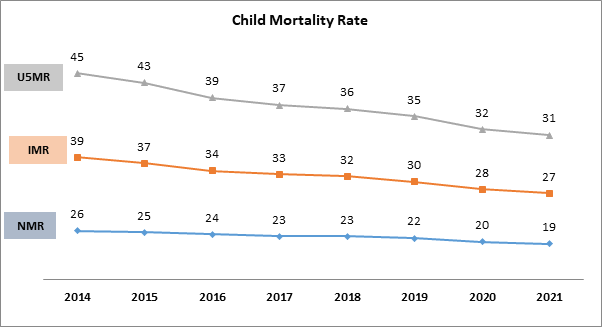India witnesses a steady downward trend in maternal and child mortality — moving closer to SDG 2030 targets
India witnesses a steady downward trend in maternal and child mortality — moving closer to SDG 2030 targets
Context
On 7th May 2025, the Registrar General of India (RGI) released the Sample Registration System (SRS) Report 2021, highlighting a consistent decline in maternal and child mortality indicators across India. The findings reaffirm the country's strong trajectory toward achieving the Sustainable Development Goal (SDG) 3.1 and 3.2 — reducing preventable maternal and child deaths by 2030.
Key Findings – Maternal Health
- Maternal Mortality Ratio (MMR):
Declined from 130 (2014–16) to 93 (2019–21) — a reduction of 37 points, reflecting substantial improvement in maternal healthcare coverage. - States achieving SDG Target (MMR ≤ 70 by 2030):
Kerala (20), Maharashtra (38), Telangana (45), Andhra Pradesh (46), Tamil Nadu (49), Jharkhand (51), Gujarat (53), Karnataka (63).
Eight Indian states have already met the SDG 2030 maternal mortality target.
Key Findings – Child Health
- Infant Mortality Rate (IMR):
Fell from 39 (2014) to 27 (2021) per 1,000 live births. - Neonatal Mortality Rate (NMR):
Reduced from 26 to 19 in the same period. - Under-Five Mortality Rate (U5MR):
Dropped from 45 to 31 per 1,000 live births. - Sex Ratio at Birth:
Improved from 899 (2014) to 913 (2021). - Total Fertility Rate (TFR):
Remained stable at 2.0, down from 2.3 in 2014, signaling near replacement-level fertility.
States Achieving SDG Child Health Targets
U5MR ≤ 25 (SDG Target):
12 States/UTs – Kerala, Delhi, Tamil Nadu, J&K, Maharashtra, West Bengal, Karnataka, Punjab, Telangana, Himachal Pradesh, Andhra Pradesh, Gujarat.NMR ≤ 12 (SDG Target):
6 States/UTs – Kerala (4), Delhi (8), Tamil Nadu (9), Maharashtra (11), J&K (12), Himachal Pradesh (12).
India’s Global Standing
- UN MMEIG Report 2000–2023 (April 2025):
- India’s MMR fell by 23 points from 2020–2023.
- 86% reduction in MMR since 1990 — compared to the global reduction of 48%.
➤ India’s progress in maternal mortality reduction outpaces global averages.
- UN IGME Report 2024 (March 2025):
- India achieved 78% reduction in Under-Five Mortality vs. global 61%.
- 70% decline in Neonatal Mortality vs. global 54%.
- 71% decline in Infant Mortality vs. global 58%.
➤ India among top-performing nations globally in child survival improvement.
Government Interventions Behind the Progress
Flagship Schemes & Strategic Interventions
- Ayushman Bharat – Pradhan Mantri Jan Arogya Yojana (PM-JAY):
₹5 lakh annual health coverage per family ensuring financial protection and access to free quality care. - Janani Suraksha Yojana (JSY) & Janani Shishu Suraksha Karyakram (JSSK):
Free institutional delivery, including caesarean sections, medicines, transport, and diagnostics. - Pradhan Mantri Surakshit Matritva Abhiyan (PMSMA):
Regular antenatal check-ups and risk detection during pregnancy. - LaQshya Programme:
Improving quality of intrapartum and immediate postnatal care. - POSHAN Abhiyaan:
Addressing malnutrition among pregnant women, lactating mothers, and children.
Infrastructure Strengthening
- Establishment of Maternity Waiting Homes, MCH Wings, Obstetric HDUs/ICUs, Newborn Stabilization Units (NBSUs), Sick Newborn Care Units (SNCUs), and Mother-Newborn Care Units.
- Enhanced screening programs for birth defects, hearing, and vision.
Clinical & Quality Improvements
- Use of antenatal corticosteroids for preterm labor.
- CPAP therapy and structured newborn follow-ups.
- Training and deployment of midwives, skilled birth attendants, and ASHA workers across rural areas.
Data & Surveillance
- Implementation of digital health data platforms for real-time maternal and child health surveillance, enabling evidence-based policymaking and resource allocation.
Impact
- Around 300 lakh safe pregnancies and 260 lakh healthy live births supported annually.
- India is ahead of global averages in reducing both maternal and child mortality indicators.
- Reflects strong policy convergence, improved healthcare delivery, and targeted social interventions.
Challenges Ahead
- Persistent regional disparities — higher MMR and IMR in a few northern and northeastern states.
- Shortage of specialized healthcare providers in rural and tribal regions.
- Need for sustained quality assurance and community-level awareness to ensure universal coverage.
Way Forward
- Strengthen primary and emergency obstetric care at all levels.
- Scale up digital monitoring and telehealth in rural districts.
- Focus on equitable healthcare access, particularly in fragile and underserved regions.
- Continue skill enhancement and quality certification of maternity facilities.


Updated - 10 MAY 2025 9:58AM | PIB